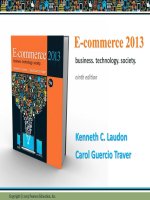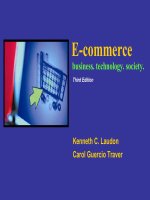Lecture E-commerce 2013: Business, technology, society (9/e): Chapter 5 - Kenneth C. Laudon, Carol Guercio Traver
Bạn đang xem bản rút gọn của tài liệu. Xem và tải ngay bản đầy đủ của tài liệu tại đây (2.26 MB, 51 trang )
E-commerce 2013
business. technology. society.
ninth edition
Kenneth C. Laudon
Carol Guercio Traver
Copyright © 2013 Pearson Education, Inc.
Chapter 5
E-commerce Security and
Payment Systems
Copyright © 2013 Pearson Education, Inc.
Class Discussion
Cyberwar: MAD 2.0
What is the difference between hacking and
cyberwar?
Why has cyberwar become more potentially
devastating in the past decade?
Why has Google been the target of so many
cyberattacks?
Is it possible to find a political solution to
MAD 2.0?
Copyright © 2013 Pearson Education, Inc.
Slide 5-3
The E-commerce Security
Environment
Overall size and losses of cybercrime
unclear
Reporting issues
2011 CSI survey: 46% of respondent
firms detected breach in last year
Underground economy marketplace:
Stolen information stored on underground
economy servers
Copyright © 2013 Pearson Education, Inc.
Slide 5-4
What Is Good E-commerce Security?
To achieve highest degree of security
New technologies
Organizational policies and procedures
Industry standards and government laws
Other factors
Time value of money
Cost of security vs. potential loss
Security often breaks at weakest link
Copyright © 2013 Pearson Education, Inc.
Slide 5-5
The E-commerce Security Environment
Figure 5.1, Page 266
Copyright © 2013 Pearson Education, Inc.
Slide 5-6
Table 5.3, Page 267
Copyright © 2013 Pearson Education, Inc.
Slide 5-7
The Tension Between Security and
Other Values
Ease of use
The more security measures added, the more
difficult a site is to use, and the slower it
becomes
Public safety and criminal uses of the
Internet
Use of technology by criminals to plan crimes or
threaten nation-state
Copyright © 2013 Pearson Education, Inc.
Slide 5-8
Security Threats in the
E-commerce Environment
Three key points of vulnerability in
e-commerce environment:
1. Client
2. Server
3. Communications pipeline (Internet
communications channels)
Copyright © 2013 Pearson Education, Inc.
Slide 5-9
A Typical E-commerce Transaction
Figure 5.2, Page 269
Copyright © 2013 Pearson Education, Inc.
Slide 5-10
Vulnerable Points in an E-commerce
Transaction
Figure 5.3, Page 270
Copyright © 2013 Pearson Education, Inc.
Slide 5-11
Most Common Security Threats in the
E-commerce Environment
Malicious code
Viruses
Worms
Trojan horses
Drive-by downloads
Backdoors
Bots, botnets
Threats at both client and server levels
Copyright © 2013 Pearson Education, Inc.
Slide 5-12
Most Common Security Threats (cont.)
Potentially unwanted programs (PUPs)
Browser parasites
Adware
Spyware
Phishing
E-mail scams
Social engineering
Identity theft
Copyright © 2013 Pearson Education, Inc.
Slide 5-13
Most Common Security Threats (cont.)
Hacking
Hackers vs. crackers
Types of hackers: White, black, grey hats
Hacktivism
Cybervandalism:
Disrupting, defacing, destroying Web site
Data breach
Losing control over corporate information to
outsiders
Copyright © 2013 Pearson Education, Inc.
Slide 5-14
Most Common Security Threats (cont.)
Credit card fraud/theft
Hackers target merchant servers; use data to establish
credit under false identity
Spoofing (Pharming)
Spam (junk) Web sites
Denial of service (DoS) attack
Hackers flood site with useless traffic to overwhelm
network
Distributed denial of service (DDoS) attack
Copyright © 2013 Pearson Education, Inc.
Slide 5-15
Insight on Business: Class Discussion
Sony: Press the Reset Button
What organization and technical failures
led to the April 2011 data breach on the
PlayStation Network?
Can Sony be criticized for waiting 3 days
to inform the FBI?
Have you or anyone you know
experienced data theft?
Copyright © 2013 Pearson Education, Inc.
Slide 5-16
Most Common Security Threats (cont.)
Sniffing
Eavesdropping program that monitors information
traveling over a network
Insider attacks
Poorly designed server and client software
Social network security issues
Mobile platform security issues
Same risks as any Internet device
Cloud security issues
Copyright © 2013 Pearson Education, Inc.
Slide 5-17
Insight on Technology: Class Discussion
Think Your Smartphone Is Secure?
What types of threats do smartphones face?
Are there any particular vulnerabilities to this
type of device?
What did Nicolas Seriot’s “Spyphone” prove?
Are apps more or less likely to be subject to
threats than traditional PC software
programs?
Copyright © 2013 Pearson Education, Inc.
Slide 5-18
Technology Solutions
Protecting Internet communications
Encryption
Securing channels of communication
SSL, VPNs
Protecting networks
Firewalls
Protecting servers and clients
Copyright © 2013 Pearson Education, Inc.
Slide 5-19
Tools Available to Achieve Site Security
Figure 5.5, Page 288
Copyright © 2013 Pearson Education, Inc.
Slide 5-20
Encryption
Encryption
Transforms data into cipher text readable only by
sender and receiver
Secures stored information and information
transmission
Provides 4 of 6 key dimensions of e-commerce security:
Message integrity
Nonrepudiation
Authentication
Confidentiality
Copyright © 2013 Pearson Education, Inc.
Slide 5-21
Symmetric Key Encryption
Sender and receiver use same digital key to encrypt
and decrypt message
Requires different set of keys for each transaction
Strength of encryption
Advanced Encryption Standard (AES)
Length of binary key used to encrypt data
Most widely used symmetric key encryption
Uses 128-, 192-, and 256-bit encryption keys
Other standards use keys with up to 2,048 bits
Copyright © 2013 Pearson Education, Inc.
Slide 5-22
Public Key Encryption
Uses two mathematically related digital keys
Public key (widely disseminated)
Private key (kept secret by owner)
Both keys used to encrypt and decrypt message
Once key used to encrypt message, same key
cannot be used to decrypt message
Sender uses recipient’s public key to encrypt
message; recipient uses private key to decrypt it
Copyright © 2013 Pearson Education, Inc.
Slide 5-23
Public Key Cryptography: A Simple Case
Figure 5.6, Page 291
Copyright © 2013 Pearson Education, Inc.
Slide 5-24
Public Key Encryption using Digital
Signatures and Hash Digests
Hash function:
Mathematical algorithm that produces fixed-length number called
message or hash digest
Hash digest of message sent to recipient along with
message to verify integrity
Hash digest and message encrypted with recipient’s
public key
Entire cipher text then encrypted with recipient’s
private key—creating digital signature—for
authenticity, nonrepudiation
Copyright © 2013 Pearson Education, Inc.
Slide 5-25









